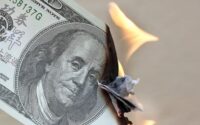Bond Traders See BOJ as the Next Big Wild Card for Treasuries
(Bloomberg) — For investors trying to figure out how to play the US Treasury market, the Bank of Japan is one of the big unknowns.
Most Read from Bloomberg
Treasuries and other major bond markets have already been shaken wildly this year, but a fresh round of volatility and yield spikes could erupt if the BOJ follows other global central banks by ditching its easy monetary policy in the face of surging inflation. While the European Central Bank is widely anticipated on Thursday to raise rates for the first time since 2011 and questions around Federal Reserve policy revolve how fast and how far officials might tighten, in Japan it’s the lift-off itself that’s in question.
Japan’s central bank was the first globally to usher in ultra-loose monetary policy, employing tools like quantitative easing and yield-curve control, and it’s set to be among the last to abandon it. That’s left it one of the few anchors globally still tethering markets to the easy-money era, so a change of course has potential to ripple through Treasuries and elsewhere.
At their meeting this week, BOJ officials are expected to keep holding rates low to stimulate the nation’s economy as consumer-price increases hold below those seen in other developed economies. But a plummeting yen is adding to speculation about how long Japan can hold out from the hawkish shift among central banks, injecting fresh uncertainty into global bond markets.
“The BOJ is very much in focus and they will remain on the radar screen of investors for the balance of the year,” said Ian Lyngen, head of US rates strategy at BMO Capital Markets. “The tail risk for the market is a less dovish BOJ that counters the consensus they will not adjust policy for this year.”
If it does change course, analysts say Treasury yields could jump higher — if only temporarily — by signaling an official end to the easy money era globally. At the same time, though, it could also rekindle Treasury buying by Japanese investors who have been on the sidelines as the US dollar rallied — or even drive down long-dated yields by intensifying the risk of a global slowdown.
The BOJ’s dovish stance has contributed to a sharply weaker yen, pushing it down over 16% this year against the dollar and sending it to the lowest level against the greenback since 1998. Over the last two months, a yen-hedged 10-year Treasury yield for Japan-based investors has fallen to around zero from 1.30%, reinforcing why the country has largely been absent from the Treasury market for much of the year.
The prospect that the BOJ will surprise markets in the coming months by removing the 0.25% yield ceiling on 10-year bonds is being eyed by some investors as a potential buying opportunity for US and euro-zone bonds.
“There is a buying opportunity if the BOJ shifts,” said Matt Smith, investment director at Ruffer LLP.
“We definitely feel that a BOJ policy shift would lead to a jump in eurozone and Treasury yields,” he said. “But the timing is a tricky one to call.”
That’s because the BOJ likely prefers sticking with its current policy stance until next April when Governor Haruhiko Kuroda’s current term ends. But Smith said the bank’s “hand could be forced in advance” by rising inflation there, “not least thanks to the weaker yen, or because of rising yields in the US” that keep luring cash.
Yet the scale of a global bond shock from a BOJ shift may be brief given that investors are already anticipating weaker growth in Europe and the US, which is exerting downward pressure on longer-term yields.
The US 10-year Treasury yield, now just above 3%, is about 20 basis points below the more policy-sensitive two-year note, a so-called inversion of the yield curve that shows investors anticipate that rates will be cut eventually as the economy weakens due to tighter financial conditions.
BMO’s Lyngen anticipates a two stage trade if the BOJ shifts its goal posts. “Knee jerk selling would drive up Treasury yields,” mainly in the two- to five-year sector, while “the second trade would be an extension of the curve flattener.” He added: “Japan joining other central banks means tighter policy will slow the global economy more, and you want to own the long end.”
(Updates yield levels.)
Most Read from Bloomberg Businessweek
©2022 Bloomberg L.P.
[ad_2]
Source link


